Perhaps the greatest of all social revolutions, and one of enormous economic consequences not that profoundly explored, began in the eighteenth-century,when Europe grew not only rich enough to support a large class of non-workers, but also began to organize the days of those who toiled into hours of work and hours of leisure: from that moment the former was bound to diminish and the latter to grow. Leisure had come to stay; man anyway, was at last on his way to turning his world into a playground.

The racing of horses, a gentleman's pleasure in old England, came to be an organized sport in the eighteenth century and a mass spectacle in the nineteenth. Jockey and mount painted by James Seymour around 1750. Read More:http://www.niceartgallery.com/James-Seymour-oil-paintings.html
Of course people used their free time to cultivate their own gardens, With leisure comes the vast proliferation of hobbies, the extension of collecting from accumulating a grab bag of curiosities to highly specialized and professional concentration. And men and women, not merely aristocrats had time to cultivate their own personalities, to turn themselves into works of art. Eccentricity, like exhibitionism, is released in a leisured world. Only the idle rich can easily be themselves.
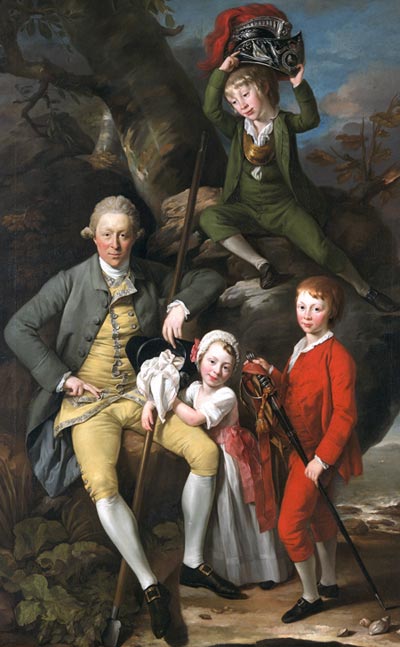
Johann Zoffany, Henry Knight of Tythegston with his Three Children, 1770. Read More:http://georgianaduchessofdevonshire.blogspot.com/2009_06_01_archive.html
Joseph Heath:When the size of the economic surplus becomes sufficiently great as to permit stable relations of exploitation, the stage is set for the emergence of an explicit class society. The predatory character of the upper class is reflected in the fact that it is not only exempt from any “industrial” employment, but is positively barred from it. This produces a sort of transvaluation of values, in which the useless becomes celebrated, precisely because it serves as sign that one is a member of the dominant class – hence the social significance of leisure. Of course, the instinct of workmanship is never entirely extinguished. Once the predatory class is sufficiently entrenched, fewer opportunities present themselves for displays of prowess. Thus this class invents for itself new, labor-intensive activities, which may involve great effort and skill, but which are demarcated from the activities of the laboring classes by virtue of being explicitly futile in their aim. …Read More:http://homes.chass.utoronto.ca/~jheath/veblen.pdf

---Surgeon William Inglis was best known as a keen member of the Honourable Company of Edinburgh Golfers, the oldest golf club in the world. Allan, a member of the same golf club, shows Inglis and his caddy on Leith Links, about two miles from the city centre, where the club was then located (it's now based at Muirfield in East Lothian). Behind Inglis, the annual trophy presented by the City - a golf club with silver balls attached - is being paraded across the Links. --- Read More:http://www.nationalgalleries.org/collection/online_az/4:322/result/0/2815?initial=A&artistId=4483&artistName=David%20Allan&submit=1
Consumer spending, is, par excellence a leisure activity. Without leisure, it is impossible to keep up with the Joneses. And the Joneses started their reckless consumer binge also back in eighteenth-century England. Meanwhile, moralists, not the least of whom was William Hogarth, were quick to stress that the road to the gallows often begins with idleness or a love of the luxuries of leisure. Even back then, men and women with time on their hands would turn to their sofas, no t.v. of course, then regarded as a danger to morals. And they recognized that the business of pornography was growing by leaps and bounds.
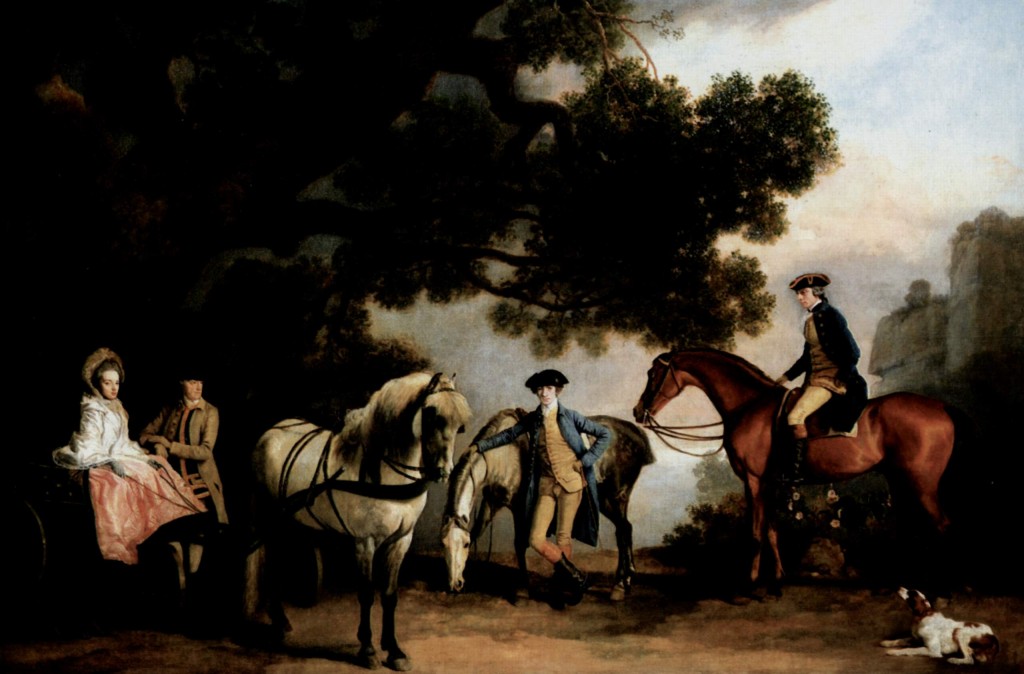
George Stubbs.The Milbanke and Melbourne Families. 1769. Read More:http://georgianaduchessofdevonshire.blogspot.com/2009_06_01_archive.html
…Joseph Heath:Sport is the most obvious example, but more controversially, Veblen also includes under this rubric religious observances, etiquette, esoteric learning (such as classical languages), aesthetic appreciation, “domestic music,” and a variety of other activities . Hence the perverse spectacle of the best (if not necessarily the brightest) applying themselves with boundless energy and selfless commitment, developing advanced competencies in activities that have absolutely no redeeming social value. The term “leisure class” is, in this respect, somewhat misleading, since members of this class often find their lives to be just as hectic and demanding as those of the laboring classes. This is why Veblen describes leisure, not as mere “indolence,” but as a “performance”. (For example, he observes that, “good breeding requires time, application and expense”. …Read More:http://homes.chass.utoronto.ca/~jheath/veblen.pdf
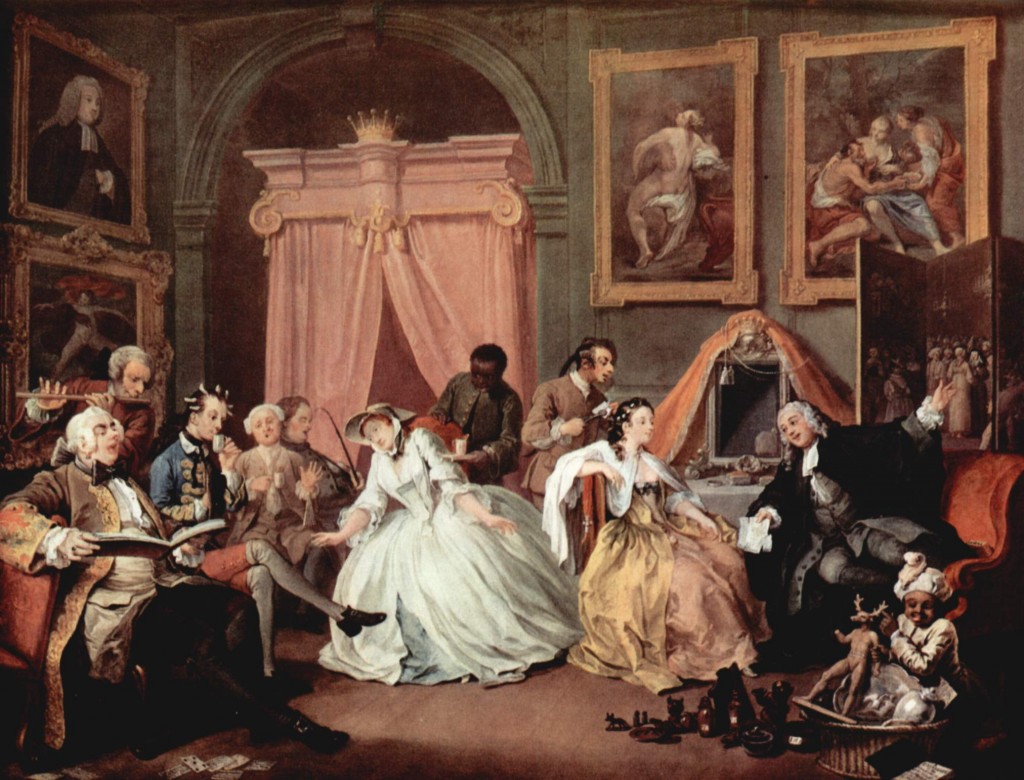
---If we look above the pink-curtained alcove we see a coronet which signifies the Viscount has become an Earl and means he has inherited the title from his late father. The Viscount is now the new Earl of Squander and his wife is now Countess of Squander. This painting is bursting with all the characters Hogarth has added. Let me introduce them to you. The now Countess of Squander is the lady on the right, wearing the yellow and silver morning gown sitting at her dressing table. On the back of her chair, tied to a red ribbon is a child’s teething coral so we know that she has become a mother. She has her back to her guests with the exception of Silvertongue, the lawyer, who she is in animated conversation with. Silvertongue is the lawyer whom we saw in the first painting as he carried out the duties of an adviser to the late Earl and consoled the unhappy viscountess. Behind her stands her hairdresser who is testing the heat of his curling tongs. --- R
More:http://mydailyartdisplay.wordpress.com/2011/05/07/marriage-a-la-mode-the-toilette-by-william-hogarth/
Many deplored the vulgarization that leisure brought, the commercialization of the arts, the exploitation of sensibility for economic ends. The worm was in the bud, even in the first riotous enjoyment of a leisured world. The pursuit of leisure was accompanied by a chorus of Jeremiahs who prophesied the decay of family and national morality.
The dangers of leisure, as the upper classes of nineteenth-century England soon learned, are boredom and guilt. A change of scene, it was quickly discovered, provided a sovereign remedy for tedium. In earlier ages few had traveled for fun, the conditions of roads and inns being too barbarous.
By 1750, the upper classes were on the move; to Scotland, Ireland, France, Italy, even Russia and Turkey. Inns improved, entrepreneurs produced guidebooks, maps, coach rental agencies; except for cheap package tours, the whole parphenalia of of modern travel was available by 1800. And towns were growing that were devoted entirely to the pursuit of leisure.
…Joseph Heath:Consider the case of waste – or to be more specific, the particular sort of waste generated by conspicuous consumption. Veblen’s criticism here is relatively simple. Some goods are valued and consumed for their intrinsic properties. Thus the “advance of industrial efficiency” leads to improvements in the quality and comfort of life. Yet property is accumulated, not just to satisfy our basic physical needs, but also for its honorific qualities. It serves as a basis for invidious comparison, not just with respect to quantity, but also quality. This sort of accumulation is collectively self defeating, for the simple reason that not everyone can be above average. The result is that, regardless of how much the standard of living rises, “the normal, average individual will live in chronic dissatisfaction with his present lot”. One way of articulating the problem to say that status (along with all of its derivative concepts, such as self-respect, esteem, honor, and merit) is essentially an ordinal ranking system, and thus the quest for status is a zero-sum game….Read More:http://homes.chass.utoronto.ca/~jheath/veblen.pdf
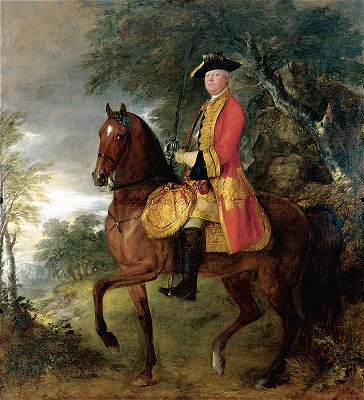
---This is by far Gainsborough's largest painting and is also his first equestrian portrait and the only one in which the rider is actually mounted. The portrait is modeled on a painting by Van Dyck (Charles I on Horseback) who was so greatly admired by Gainsborough. The mature style so richly in evidence in this canvas was the result of Gainsborough's exposure to major collections in Bath and its environs, which transformed his art. An accomplished landscape painter, Gainsborough replicated the wooded setting of the General's estate, Marks Hall, which evokes a tranquil mood thru the play of light. Honywood has a glint in his eye as if he is still ready to lead the charge. Were it not for his military garb and sword, however, he would appear more like a country gentleman enjoying a ride on his estate, as he no doubt often did. In this work Gainsborough sought to emulate the pictorial formulas successfully employed by Titian and Anthony Van Dyck which combined grandeur of scale with fluid brushwork.--- Read More:http://www.willemswebs.com/ringlingdocents/honeywood.htm
True, the lingering sense of guilt that hinted of the immorality of idleness required an excuse. Travel was justified as improving the mind. Health provided the reason for a prolonged stay at a spa or seaside resort. The waters of Bath were famous, and a visit to the Pump Room soothed the conscience amid the balls, assemblies, plays, the ogling, love-making, and gambling that made up a day there. Everyone who could afford it swarmed to Bath for-although they would not admit it: a holiday.
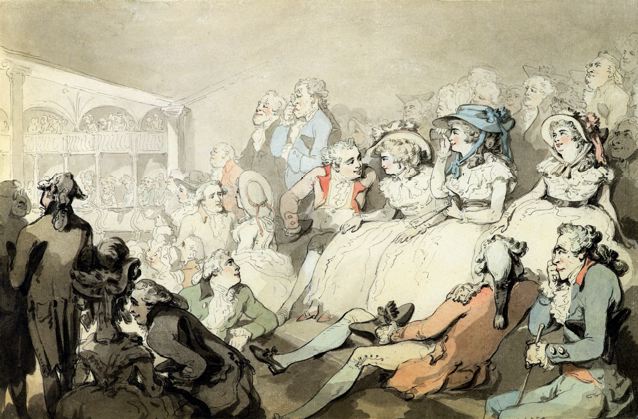
---Thomas Rowlandson,“An Audience Watching a Play at Drury Lane Theatre,”ca. 1785. Also talking,flirting,gawking,lounging. (Yale Center for British Art)--- Read More:http://fakeshakespeare.com/photos/
When Dr. Richard Russell sold the idea of sea bathing as a route to health, Brighton quietly became the eighteenth-century Miami, a tiny village burgeoning into a town based purely on visitors and retired residents. There, oddly enough, men and women bathed in the nude, although segregated , and many gentlemen spent a happy morning viewing beauties through their telescopes. This was the beginning of Atlantic City, Saint-Tropez, of that endless array of communities that stretches along the coasts of the civilized world, providing delectation for the leisured and profit for those who exploit them.
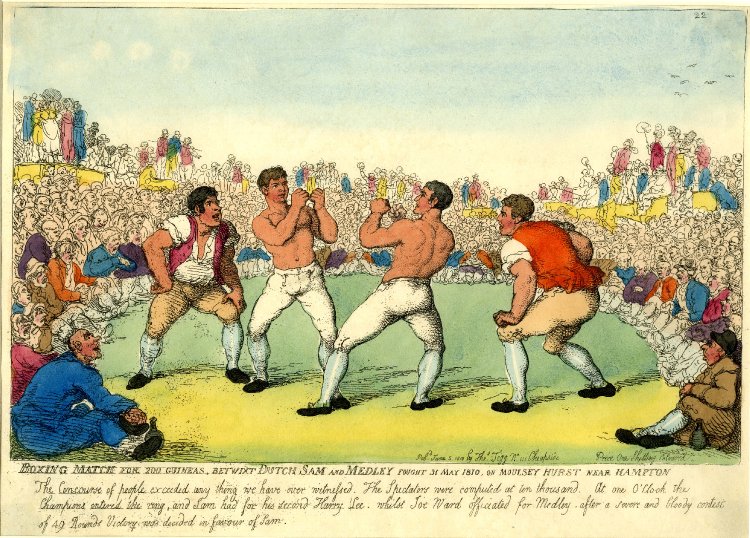
---The caption of this Thomas Rowlandson print reads: Boxing Match for 200 Guineas betwixt DUTCH SAM and MEDLEY fought 31 May 1810, on MOULSEY HURST near HAMPTON The Concourse of people exceeded any thing we have ever witnessed. The Spectators were computed at ten thousand. At one O'Clock the Champions entered the ring,and Sam had for his second Harry Lee, whilst Joe Ward officiated for Medley, after a severe and bloody contest of 49 Rounds Victory was decided in favour of Sam.--- Read More:http://scribalterror.blogs.com/scribal_terror/nineteenth_century/page/2/
…Joseph Heath:The problem is that, because of the collective action problem induced by conspicuous consumption, this gain in utility is ephemeral. It is undone the moment a “fresh increase in wealth” gives rise to “a new standard of sufficiency” and “a new pecuniary classification of one’s self”. Thus the outcome of competitive consumption is unsatisfactory, not according to some “external” standard imposed by the critic, but according to the preferences of the consumers themselves. It is for this reason that waste of this sort fails to satisfy what Veblen calls “the economic conscience”. There is of course an influential line of thinking, descended from antiquity, that emphasizes the insatiability of human desire. This was based upon a commonly observed psychological tendency, through which the satisfaction of one desire gives rise to several more. The significance of Veblen’s analysis lay in his redirection of our attention away from the psychological toward the social, and away from the mental state toward the object of desire. From this perspective, it is natural to expect that the rate of growth of “the pecuniary standard of decency” would be a function of the rate of growth of the economy.Read More:http://homes.chass.utoronto.ca/~jheath/veblen.pdf
ADDENDUM:
Joseph Heath:Veblen considers the status hierarchy, as a system of invidious comparison, to be more fundamental than other major categories of contrastive judgment, such as aesthetic taste or the moral sense. For example, “the superior gratification derived from the use and contemplation of costly and supposedly beautiful products is, commonly, in great measure a gratification of our sense of costliness
masquerading under the name of beauty”(1899, 128). This is because “our higher appreciation of the superior article is an appreciation of its superior honorific character,” not its brute aesthetic qualities, and its honorific character arises from the way its consumptions “fits” into the background status hierarchy.
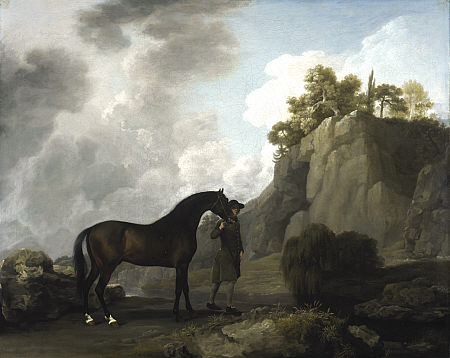
---The grey, green and brown tones of the rocky setting provide an effective foil for this refined portrait of a magnificent Arabian stallion and groom. The painting was one of twelve commissioned from Stubbs by one of his most important and richest patrons, Charles Watson-Wentworth, 2nd Marquess of Rockingham (1730-1782). Among Rockingham's passions were breeding racehorses and collecting sculpture for his family home, Wentworth House, Yorkshire (known as Wentworth Woodhouse). He was twice, briefly, appointed Whig Prime Minister. --- Read More:http://www.nationalgalleries.org/collection/online_az/4:322/result/0/60800?initial=S&artistId=6783&artistName=George%20Stubbs&submit=1




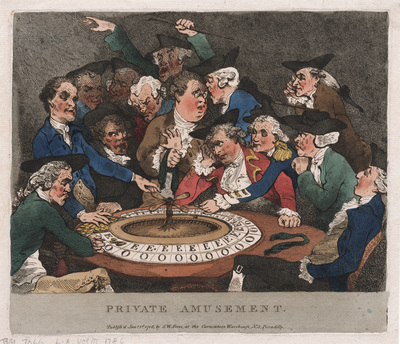





 COMMENTS
COMMENTS



